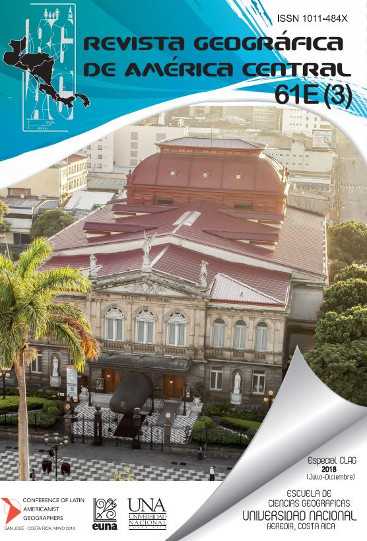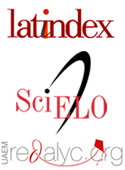El mapeo de los cambios de usos de subsistencia de la tierra en el Concejo Territorial Miskito, Katainasta, Honduras
DOI:
https://doi.org/10.15359/rgac.61-3.33Palabras clave:
Honduras, Miskito, concejo territorial, indígena, manejo de recursos naturalesResumen
Understanding the large-scale spatial patterns of natural resource use in indigenous homelands is critical for guaranteeing indigenous peoples’ ancestral land rights, designing effective conservation policies, and promoting good governance in Central America. However, few studies have mapped the diachronic distribution of indigenous communities’ resource use in these areas. Here we present a case study describing the spatial functionality of the Concejo Territorial Katainasta (CTK)--the first indigenous territorial jurisdiction in Honduras to receive an intercommunity land title. Two participatory research mapping (PRM) studies--the first in 1992 and the second in 2014-15--mapped the spatial patterns of Miskitu subsistence activities in CTK. The results were subsequently converted into a geographic information system (GIS) that allowed for spatial and temporal comparisons of Miskitu subsistence livelihoods in CTK before and after the titling process. Here we focus on the spatial parameters of three Miskitu subsistence livelihoods: agriculture, hunting and fishing. Analysis of results suggests that 1) the 2014-15 subsistence use areas for Miskitu communities in CTK have not diverged dramatically from those of the 1992 study, and 2) the new legal boundaries of CTK adequately encompass the subsistence use areas of its constituent communities and recognize the historical overlaps in Miskitu resource use and tenure patterns.
Referencias
Álvarez, R., Pantoja, E., Granados, G. & Paz, A. (2017). “Strengthening Indigenous Peoples Land Rights in Honduras: The Miskitu People's Experience of Collective Land Titling, Lessons Learned, and Main Challenges for the Future.” Paper presented at the 2017 World Bank Conference on Land and Poverty, Washington, D.C.
Cochran, D. M. (2008). Who Will Work the Land? National Integration, Cash Economies, and the Future of Shifting Cultivation in the Honduran Mosquitia. Journal of Latin American Geography, 7(1), 57-84.
Dunn, M. A. & Smith, D. A. (2011). The Spatial Patterns of Miskitu Hunting in Northeastern Honduras: Lessons for Wildlife Management in Tropical Forests. Journal of Latin American Geography, 10(1), 85-108.
Galeana, F. & Pantoja, E. (2013). Strengthening Indigenous Peoples' Land Tenure Governance: The Case of the Miskito People in Honduras. Paper presented at the Annual World Bank Conference on Land and Poverty, Washington, D.C.
Herlihy, P. H. (2001). Indigenous and Ladino Peoples of the Río Plátano Biosphere Reserve, Honduras. In S. C. Stonich (Ed.), Endangered Peoples of Latin America: Struggles to Survive and Thrive (pp. 100-120). Westport, CT: Greenwood Press.
Herlihy, P. H. & Knapp, G. (2003). Maps of, by, and for the Peoples of Latin America. Human Organization, 62(4), 303-314.
Herlihy, P. H. & Leake, A. P. (1997). Participatory Research Mapping of Indigenous Lands in the Honduran Mosquitia. In A. R. Pebley & L. Rosero-Bixby (Eds.), Demographic Diversity and Change in the Central American Isthmus (pp. 707-736). Santa Monica, CA: Rand Books.
Herlihy, P. H., Tappan, T. A. & Fahrenbruch, M. L. (2018). Recognizing Indigenous Territories in Central America. Paper presented at the 35th Conference of Latin Americanist Geographers, San José, Costa Rica.
INA. (2012). Título Definitivo de Propiedad Intercomunitario en Domino Pleno (Concejo Territorial KATAINASTA). In Registration No.2621.
Descargas
Publicado
Cómo citar
Número
Sección
Licencia
Política propuesta para Revistas que ofrecen Acceso Abierto
Los autores que publican en esta revista están de acuerdo con los siguientes términos:
a. Los autores conservan los derechos de autor y garantizan a la revista el derecho de ser la primera publicación del trabajo, bajo la Licencia https://creativecommons.org/licenses/by-nc-sa/4.0/deed.es, que permite a otros compartir con un reconocimiento de la autoría del trabajo y la publicación inicial en esta revista.
b. Los autores pueden establecer por separado acuerdos adicionales para la distribución no exclusiva de la versión de la obra publicada en la revista (por ejemplo, situarlo en un repositorio institucional o publicarlo en un libro), con un reconocimiento de su publicación inicial en esta revista. Esos acuerdos adicionales deben respetar los términos de la licencia: es decir: no involucrar fines de lucro y compartir con la misma licencia.
c. Se anima a los autores a archivar el post-print o versión de editor/PDF en repositorios de acceso abierto.







 REVGEO se encuentra bajo la licencia https://creativecommons.org/licenses/by-nc-sa/4.0/deed.es
REVGEO se encuentra bajo la licencia https://creativecommons.org/licenses/by-nc-sa/4.0/deed.es
.svg_4.png)

_(1).png)
_(1)_(1)_(1)_1.png)
(2)(1)(1)(1).png)
